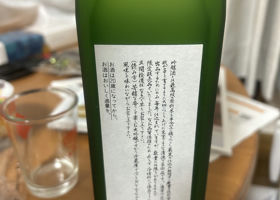Timeline
酔生夢死Slightly sweet aroma of koji mold 🍶.
Flat taste on the palate
Bitter and pungent taste
The back of the throat gets hot.
Slight bluishness in the aftertaste: 🙆♂️
Absinthe...?
Alcohol percentage 19.0%.
Sake strength +4.0
Acidity 1.5
Amino acidity 1.6
Koji rice: Yamadanishiki
Kake rice: Gohyakumangoku, etc.
Rice polishing ratio 60
Yeast used: Association No. 701, M310 酔生夢死Rice: Domestic rice ■Polishing ratio: 50% ■Alcohol content: 15% ■Sake alcohol content: Undisclosed ■Acidity: Undisclosed
Shinshu" released from November to February is defined as "new sake made from new rice.
Sake made over a four-month period as "shinshu" may use different rice each time, and the details are not disclosed. ⭐️
Luscious aroma
Piquant mouthfeel
Classy sweetness
Pleasant acidity
Spiciness typical of new sake
Shiratama (white ball) flavor
Ripe apple aroma
The astringency that makes the tongue feel tight is also good. 酔生夢死Low aroma
Slightly sweet and sour
Sweet and sour with a touch of elegance
Peppery alcohol brings the whole thing together.
The whole wine is well balanced and has a good aftertaste.
Good balance and good aftertaste.
The lingering aroma is also very elegant.
Rice: 100% Aomori rice ■Polishing ratio: 55% ■Alcoholicity: 16% ■Sake degree: -2.0 ■Acidity: 1.4 Amino acidity: 1.1 酔生夢死Refreshing scent of apple
spicy
Cider flavor with
Bitterness, good sharpness
Low in alcohol, yet robust
And yet it has a touch of elegance.
Junmai Ginjo-nama sake made from 50% polished Hachitan-Nishiki grown in Hiroshima Prefecture. It uses Kochi yeast (CEL-24), which was developed at the Kochi Prefectural Industrial Technology Center to produce highly aromatic sake.
Alcohol content: 14%.
Sake strength: - 12
Acidity: 1.8
Rice used: Domestic rice
Rice polishing ratio: 50 酔生夢死Soft and piquant mouthfeel
Cute, juicy, sweet and delicious
Solid alcohol
Bitterness lingers on the bottom 👍
A rich, punchy food wine.
Great with solid meat and oil dishes. 🙆♂️
Very reasonable price.
This is a standard sake made with Yamada-Nishiki rice, which is partly out of the standard range.
Condition: fired
Polishing ratio: Kake 70%, Koji 50/60
Yeast: Kyokai No. 1801, No. 1401
Raw material rice: Non-standard Yamadanishiki (Yamaguchi)
Alcohol 16.6 酔生夢死Ramune-like fresh aroma
spunky
Lovely acidity
voluminous alcohol
Bitterness in the aftertaste
Product Details
Rice used: Niigata rice
Polishing ratio: Koji rice: 50% / Kake rice: 50
Sake degree: -2
Acidity: 1.8
Amino acidity: 1.2
Alcohol content: 15
Made with Niigata yeast "G74 Wakaebisuワカエビスプラス002 ガス ピチピチワクワクナマゲンシュ!純米吟醸原酒生酒無濾過おりがらみ 酔生夢死100% Mie Yamadanishiki
Polishing ratio 60
Alcohol content 16%.
Basic composition values Sake meter / -5.1
Acidity / 1.6, Amino Acidity / 0.7
Opened 1 month
The gasiness of this one is weak from the moment it is opened.
Gentle sweet and sourness
Moderate thickness and length on the finish.
Eye-catching label and
and a long, modern-style title (sake name) 酔生夢死1 month after opening the bottle
Rice / Percentage of rice used] Domaine Sakura, 80% Yumachi
Rice / Percentage of rice used: 20% Yamadanishiki (produced in Sakura City, Tochigi Prefecture)
90% polished
Alcohol Content】13%(Draft)
Yeast used] Undisclosed
Sake meter] Undisclosed
Acidity] Not disclosed
Banana aroma, grapefruit acidity, and a hint of bitterness.
grapefruit acidity and a hint of bitterness.
As the name suggests, it is a modern and fresh bottle. 酔生夢死Ingredient rice Miyamanishiki
Water used for brewing: Soft water from an underground spring on the brewery grounds
Alcohol content 13%.
Yeast: 601 yeast
Touji, Tatsuya Abe, was the number 2 in the production section of Tate-no-kawa Sake Brewery when he was selected as the production manager of Ou Proud (2017). 酔生夢死The aroma is calm and gentle on the palate.
Gentle on the palate
Lovely sweet and sour taste
Spring-like gorgeous hints of fragrance. ⭕️
The aftertaste is also fresh.
Rice: Yamadanishiki (Hyogo Prefecture)
Rice polishing ratio: 60
Yeast: ---- (yeast)
Alcohol content: 15%.
Sake degree: -2
Acidity: 1.5 酔生夢死Rice used
Hitanishiki
Rice polishing ratio
45
Alcohol content
15 degrees Celsius
Sake Degree
+8
Acidity
1.4
Yeast
Princess Michiko
Gorgeous aroma typical of Raifuku: ⭕️
Moderate sweetness and fresh acidity
Pleasant bitterness
A glamorous bottle 🍶. 酔生夢死Ingredients : Rice (domestic), Rice malt (domestic)
Rice Polishing Ratio:60
Alcohol content: 16
Sake meter degree: +8
Sai-no-Kizuna produced in Saitama Prefecture
Limestone hard water (hardness: 148mg/l)
Association 901 yeast
Calm aroma
Moderate sweetness and moderate acidity ⭕️
Sense of rice grain
Bitterness is firm but
Well-balanced body 酔生夢死🟥President's Aged Liquor 32 Birth Pre
Alcohol content 17.0-17.9
Yoshiki Kashima, Toji
Manufactured 99.12 酔生夢死🟥Okan birth57🍣🍰.
Polishing ratio 58% (super flat rice)
Yeast used: Daishichi yeast
Ingredients: Rice (domestic), Rice malted rice (domestic)
Ingredient Rice Gohyakumangoku
Rice grown in -
Toji Takanobu Sato (Nanbu Toji, Contemporary Master Craftsman)
Alcohol 15% abv. ma-ki-Good evening, Drunken Dream Death.
Happy birthday to your mother 🎉!
You celebrated with sushi with your family ✨.
Sushi paired with sake is my favorite combination 🤤.
It was a wonderful time of drinking 😊. 麺酒王Good evening, Drunken Dream Death 😃.
Happy birthday to your mother 🎉.
That's some awesome looking dai shichi 😲I've never seen anything like it ‼️ Sushi, wonderful sweets and a special day for you 😌. RecommendedContentsSectionView.title

































